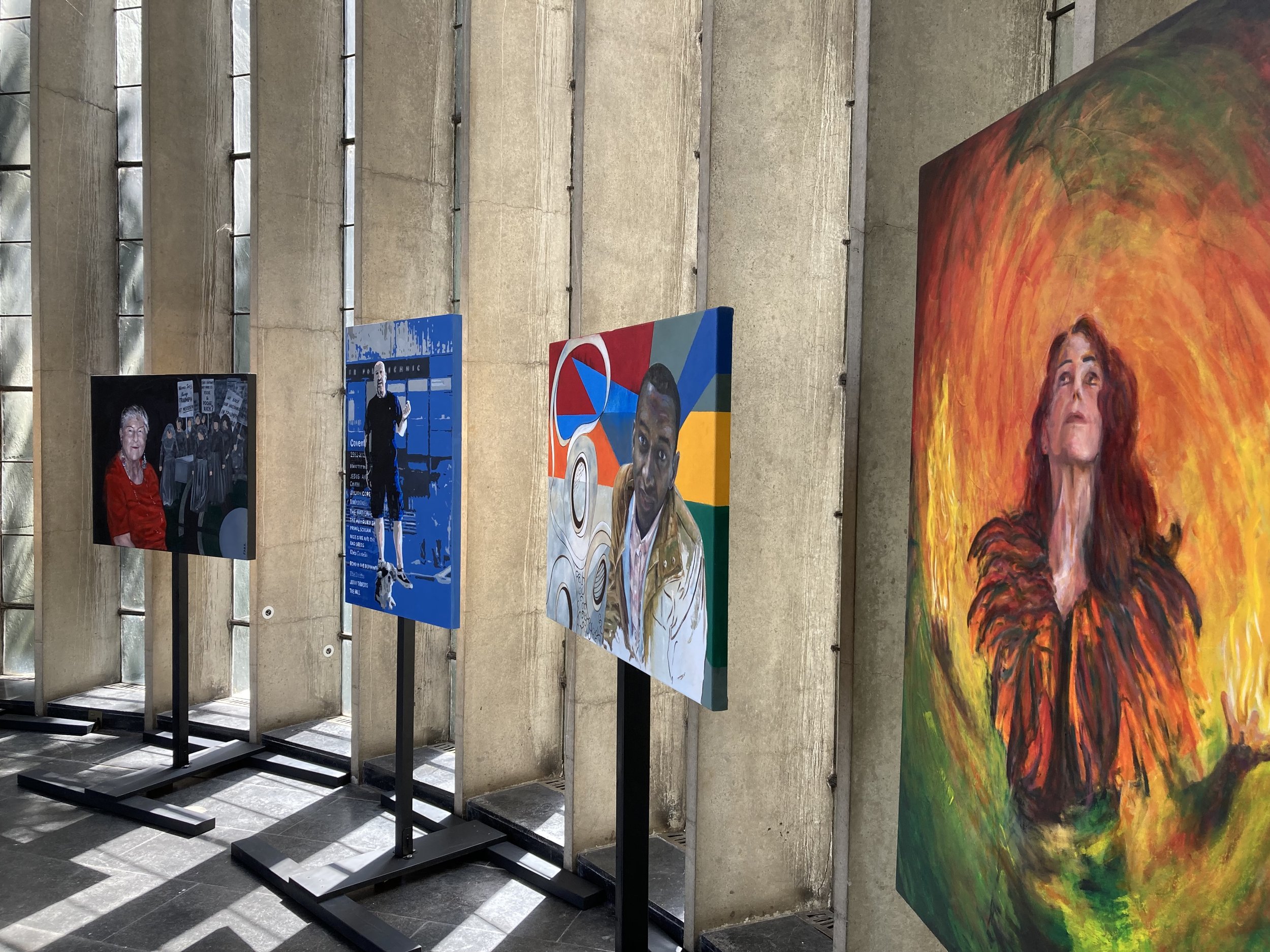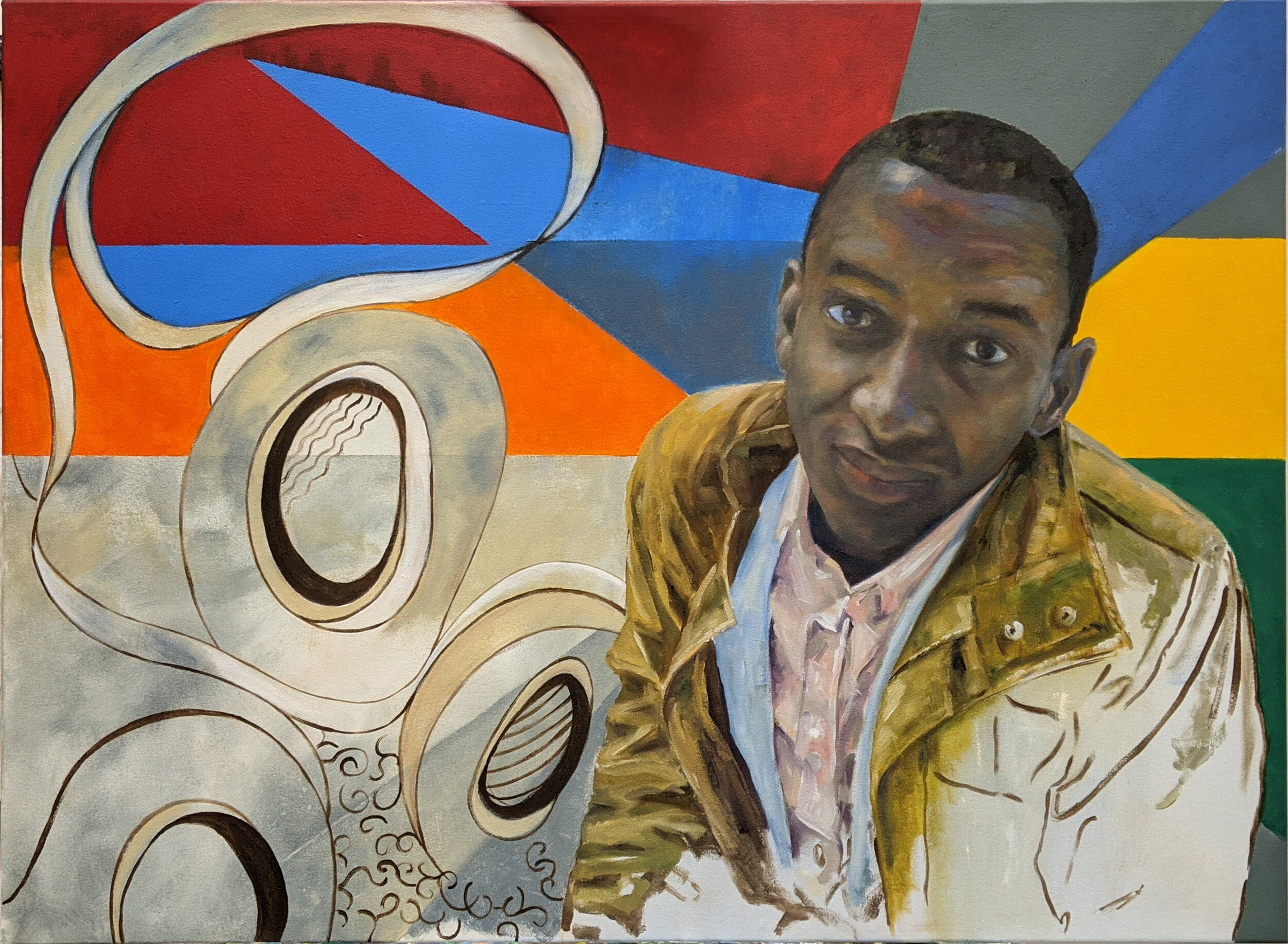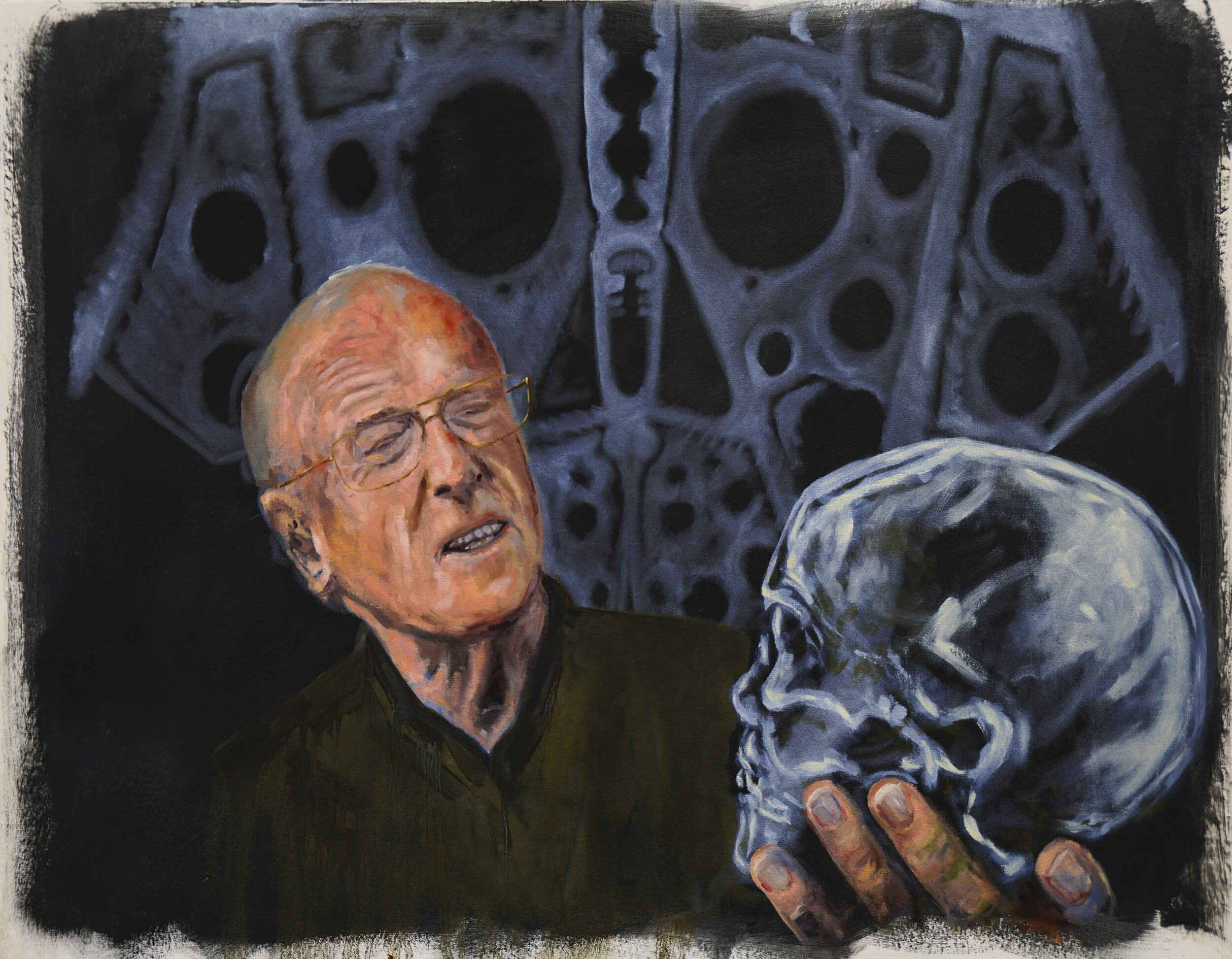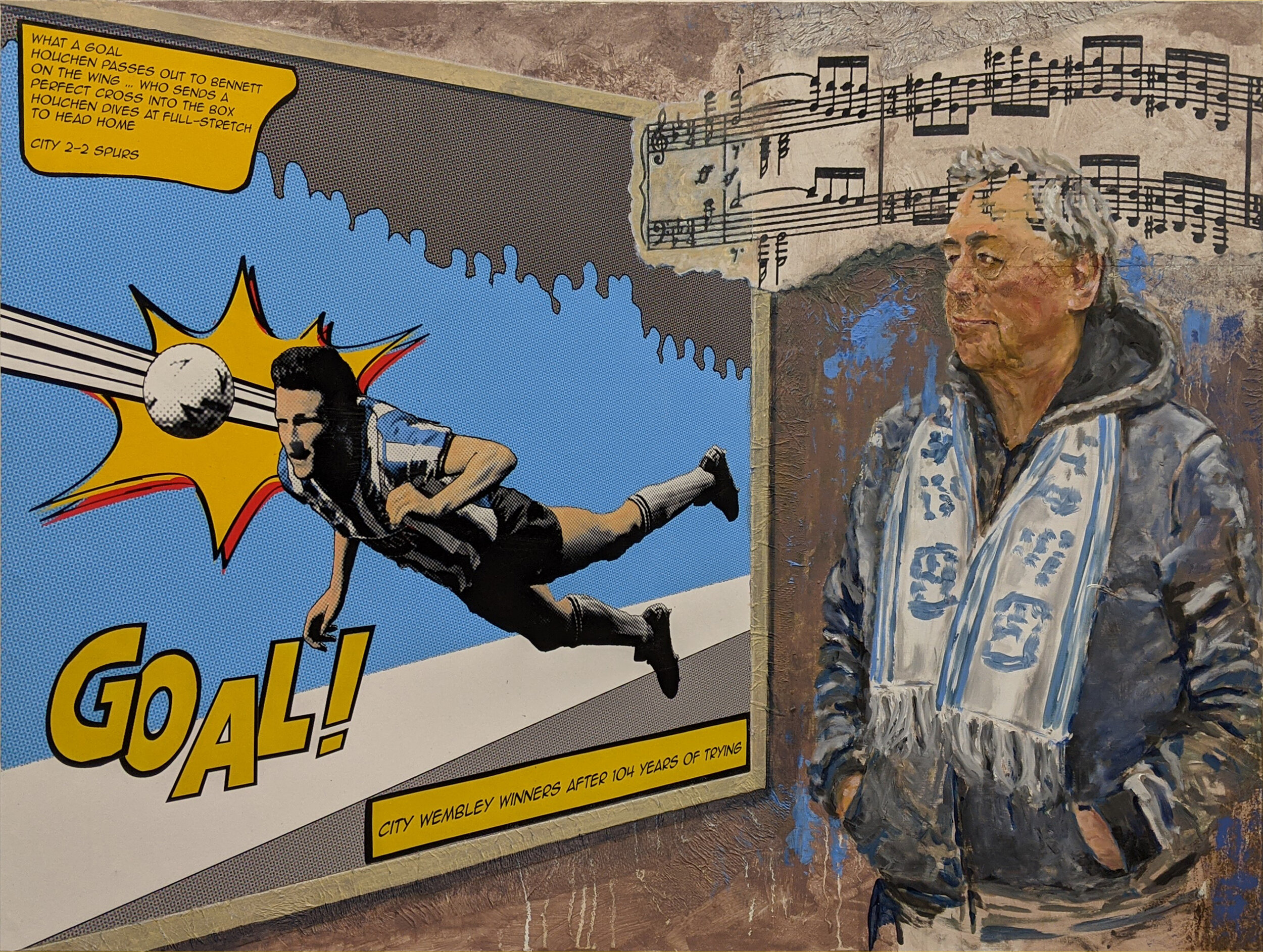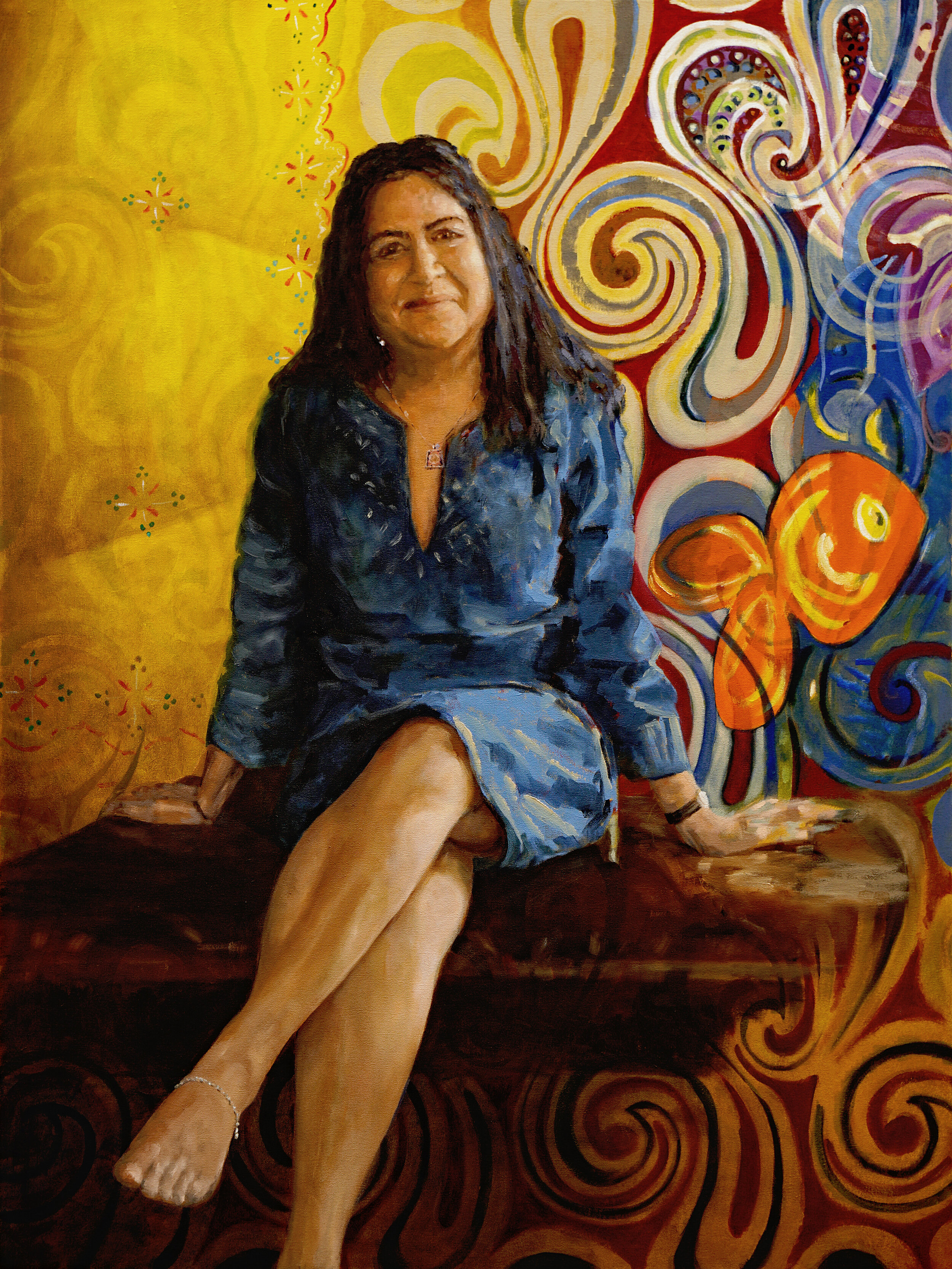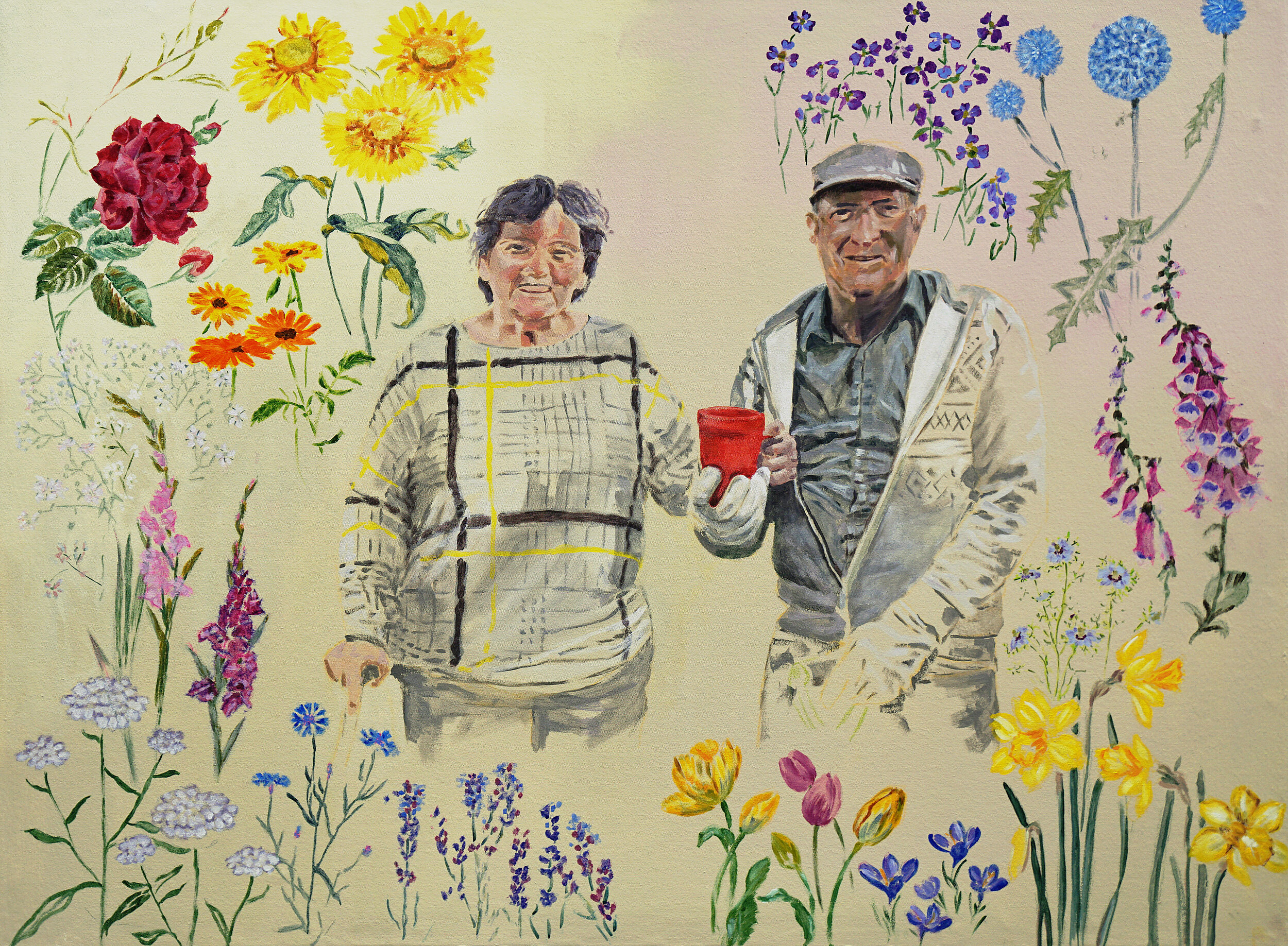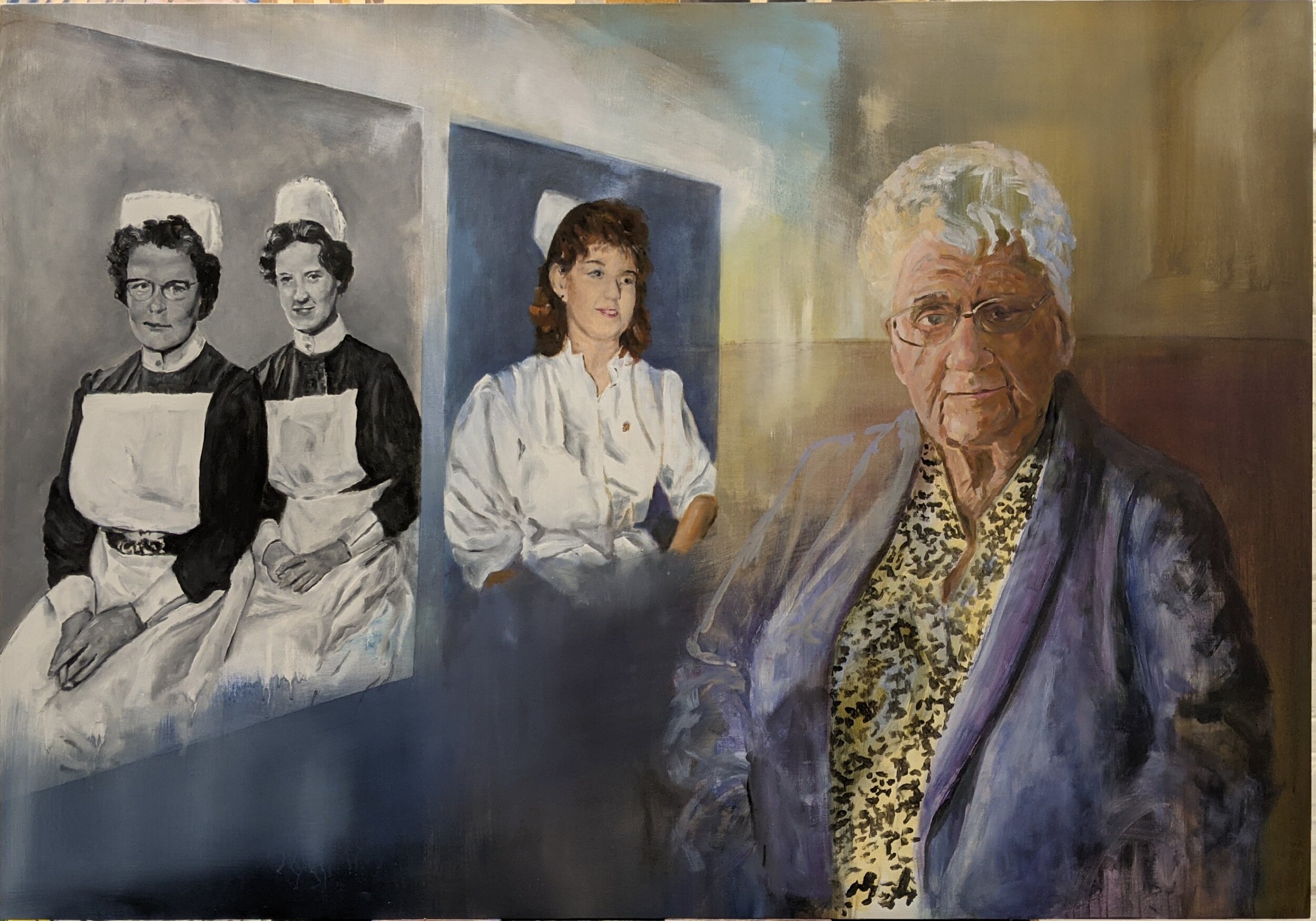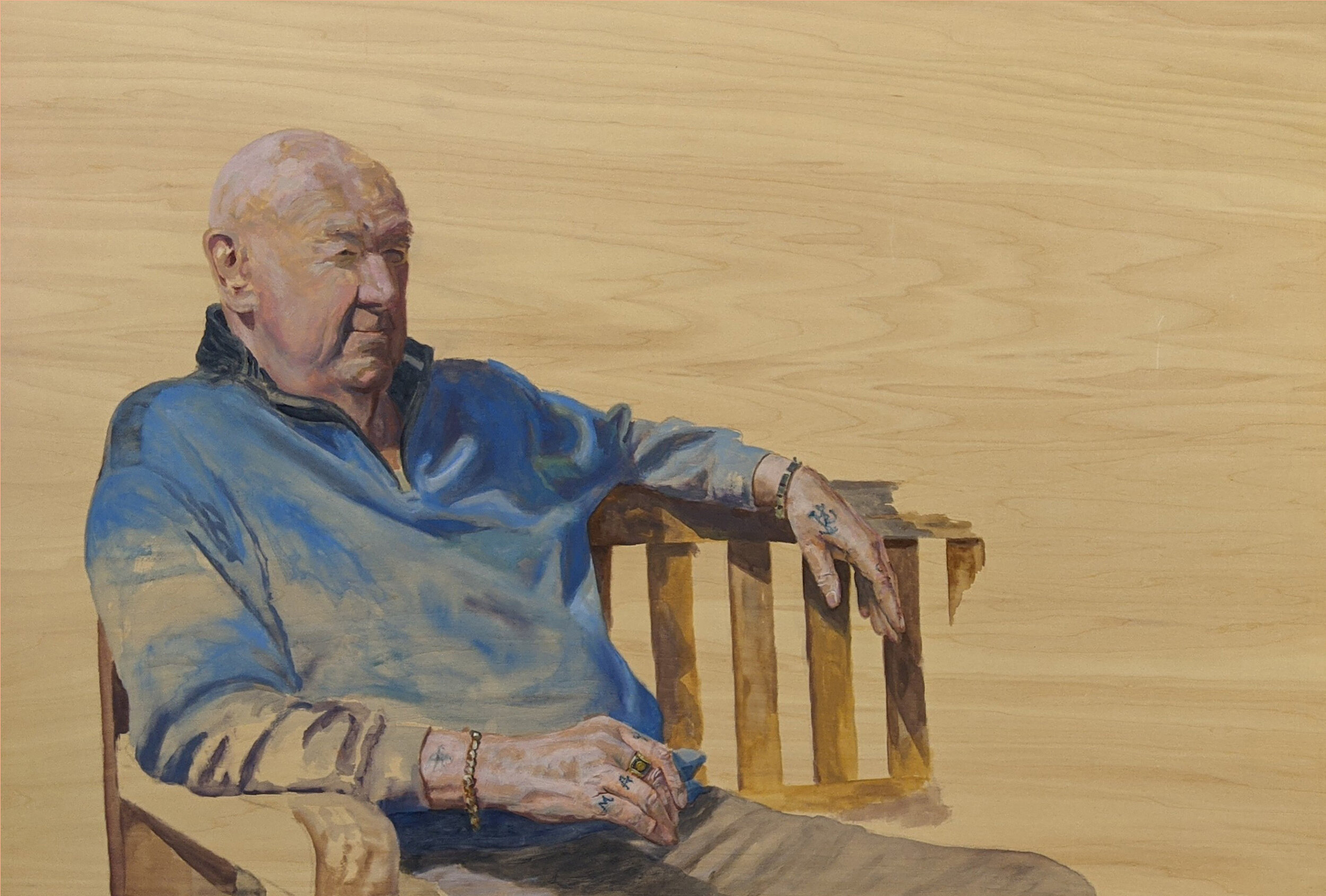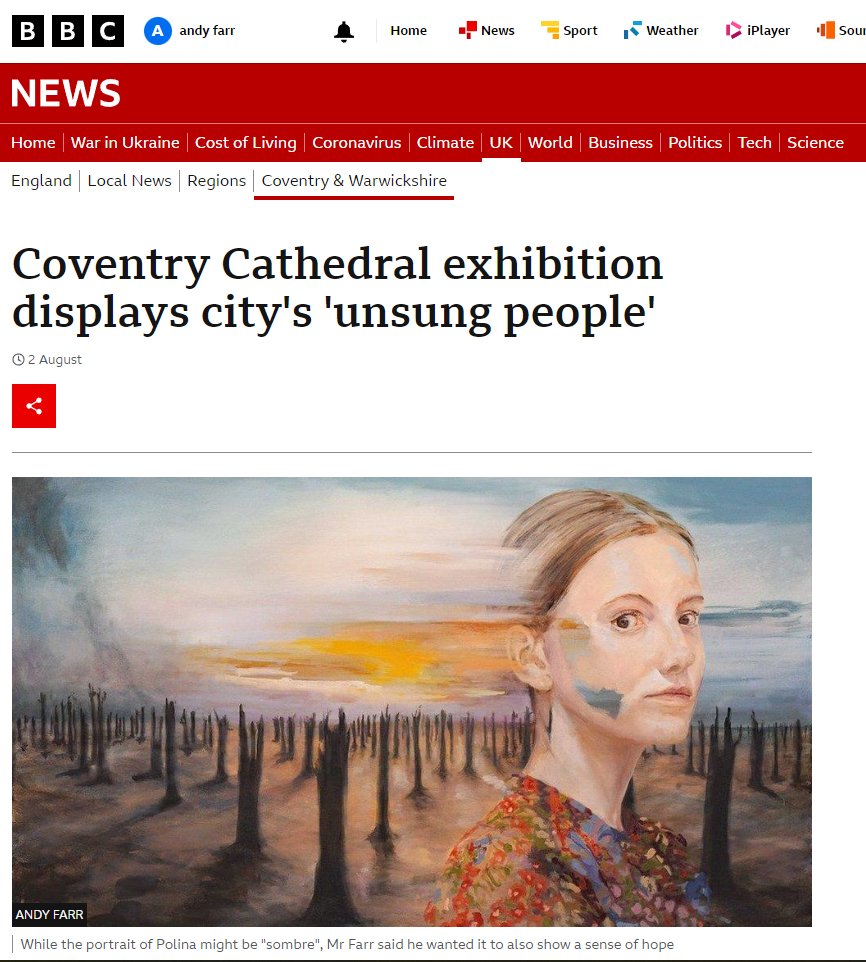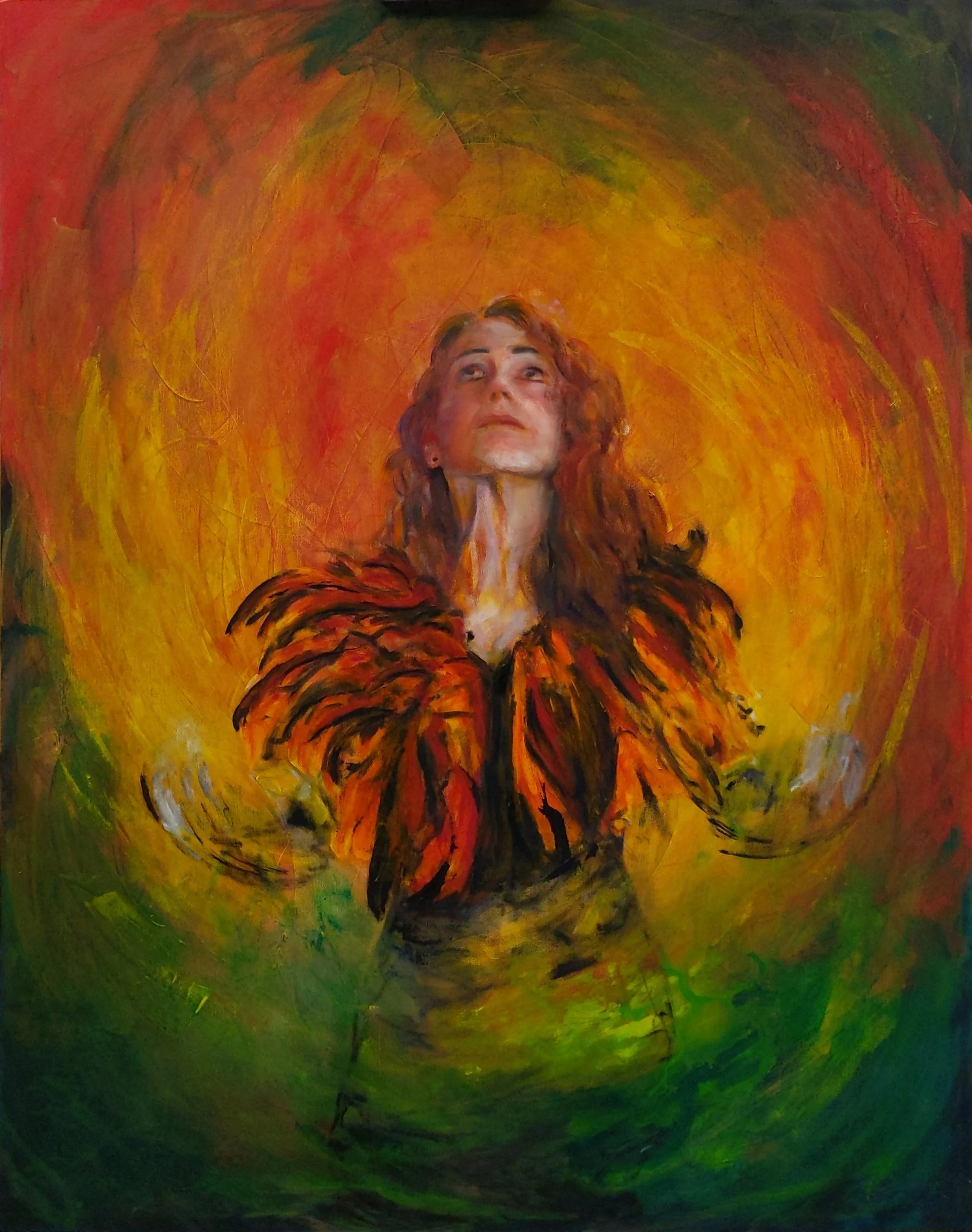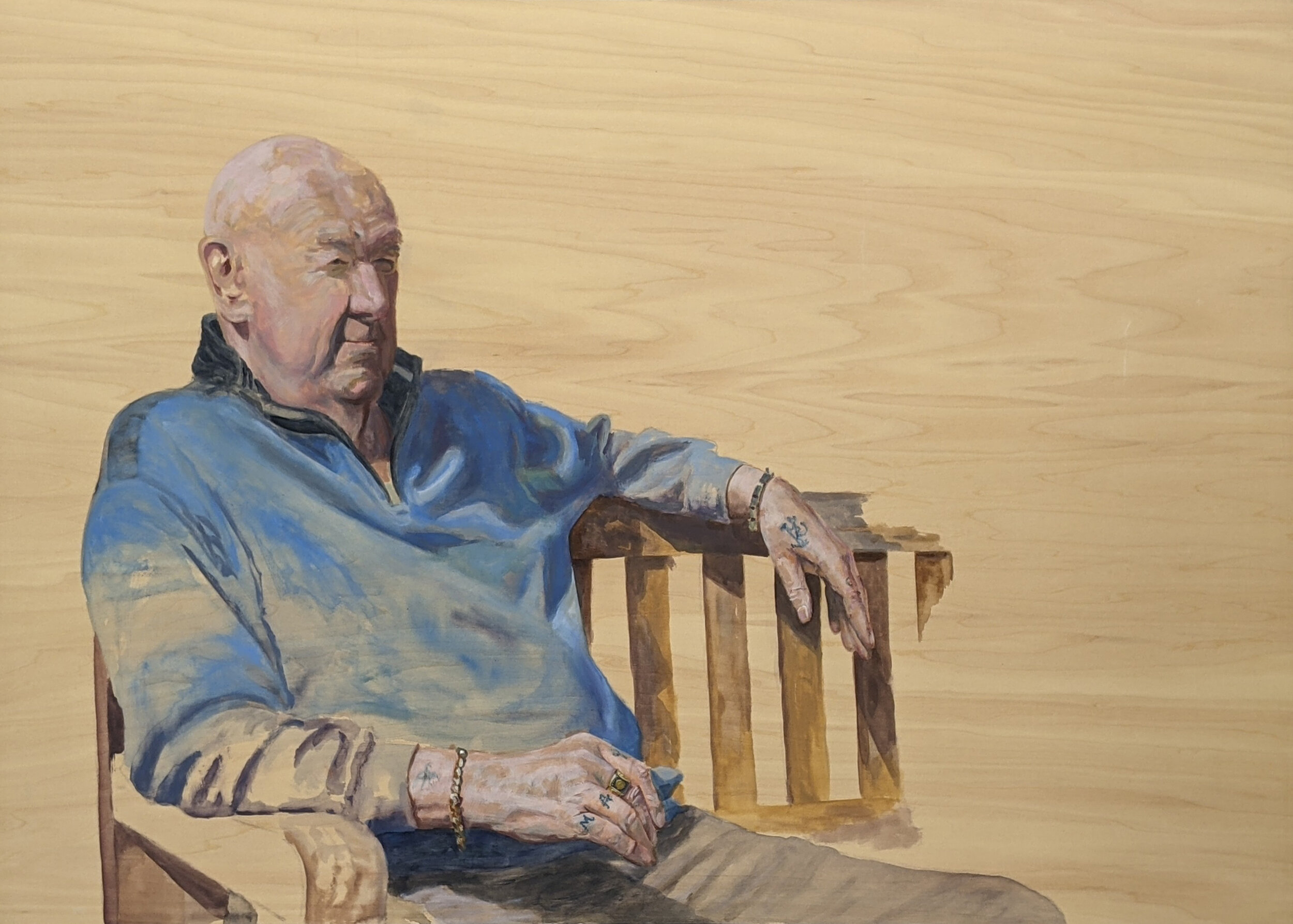Portraits of Coventry
The closing exhibition in Coventry Cathedral was incredibly well received, over 10,000 visitors, featured on the BBC Online and twice on local radio.
The series of paintings were created as a celebration of the heritage, lives and memories of people who live in Coventry – Some who had lived all their lives in the city, others who came to find employment or sanctuary.
Each painting was based on conversations Andy had with the participants over the past two years focussing on memories of their life in Coventry.
The paintings were first exhibited as part of Coventry City of Culture in 2021, and then in 2022 in Coventry Cathedral.
The project was funded by Orbit a not-for-profit housing association.
Andy Farr is an award-winning artist with a studio in Coventry’s Canal Basin. He graduated from Coventry University with an MA in Painting in 2017.
Coventry Cathedral
Read the stories behind the paintings
Polina
Polina came to Coventry recently to escape the conflict in Ukraine. She and several generations of her family have lived in the city of Kramatorsk in the Donetsk region of Ukraine.
Polina, like many Ukrainians, has a strong link to nature. She remembers as a child being taken for walks in the forest, fishing, and picking mushrooms. Her father has for many years been closely involved in a project to create a nature restoration zone, actively working to support flora and fauna. That forest has now been destroyed, part of the continuing tragedy resulting from Russia’s invasion.
Making clothes is a family tradition dating back to WW2. Polina’s great-grandmothers repaired and transformed old clothes into new ones, including some made from sky-blue parachutes, thereby earning something to survive during Nazi Occupation. Before fleeing Ukraine Polina studied as a fashion designer and created clothes in Ukraine for 5 years and was getting ready to create her own environmentally responsible clothing brand.
Sadly, her father now wears the camouflaged clothes she designed for him to wear when protecting nature as he fights to defend Kramatorsk.
The background for Andy’s painting is based on pictures and film Polina took of the forest before the war started, but now shows its destruction. He hopes that whilst the painting is sombre in tone it also coveys a sense of hope: A hope born out of the spirit and strength of the Ukrainian people to defend their country and embodied in the yellow of the dawn light cast across the landscape.
Peter
Peter’s association with Coventry Cathedral dates back to before its consecration. As a 6 year old he remembers getting to worship through the building site. He and his family were at the consecration ceremony in 1962. His parents continued to be very involved in the life of the cathedral including as Church Wardens, and his mother was the Cathedral Bread maker for many years. Peter moved away to work in London but maintained his connection to the Cathedral through his family and recent involvement in the installation of new Sound & Streaming systems.
Peter has a love of practical sciences and following a degree in Electrical Engineering joined the BBC in 1976 as a project engineer in TV studios. He was closely involved in the developments of CEEFAX and world leading work in Access services for Digital Television, audio & VOIP and 8K TV. He has a passion for training and mentoring.
In 2012, Peter reformed the UK Section of the Society of Motion Picture & Television Engineers (SMPTE) and grew it to be the third largest SMPTE section within four years.
Peter’s love of television dates from seeing the behind the scenes around the consecration - and he has been involved for many broadcasts from the cathedral – including Tangerine Dream in 1975 and BBC One on Christmas Day 2021
Andy’s painting of Peter draws on both his life-long association with the Cathedral itself and his role as a TV Engineer. The painting composition interweaves the iconic tapestry of Christ in Glory by Graham Sutherland, which Peter remembers laid out on the floor before it was hung, with patterns and colours drawn from the SMPTE logo and CEEFAX pages.
Julia
The idea for Julia’s painting emerged from a ‘Phoenix’ cape she created as a personal response to the collective anxiety experienced following the pandemic, and the ongoing economic and climate crisis. She has always been drawn to the myth of the Phoenix bird, both the imagery and the symbolism behind it “it has a strong connection to my home city and its regeneration and renewal from the ashes of war: Phoenix Rising”.
Julia is a fashion designer and maker. Julia was born and raised in Coventry and completed her technical qualifications in fashion design at Coventry Technical College, where she was taught by many of the same team who now run the successful Fashion degree course at Coventry University. She founded her first clothing brand, Medusa, with start-up finance from Coventry City Council and the Prince’s Trust. She has worked with many gothic and alternative rock bands.
During the first Covid-19 lockdown she began to make face masks for friends and family and now has a successful online Etsy shop ‘Fallen Masques’. Her designs are inspired by the gothic aesthetic, Victorian era clothing, the pre-Raphaelites, dark fairy tales, the natural world and mystical elements. Many of items are made from reclaimed vintage fabrics and trimmings.
The ‘Phoenix’ cape in the painting is embellished with organza remnants repurposed from a long- forgotten college project and velvet ribbon rescued from a 1960s mini dress!
As well as being a designer, photographer, and community organiser she was a City Host for @coventry2021 City of Culture, and she is passionate about the arts as a way of celebrating diversity and bringing people together. You can see more of Julia’s work through her Instagram @jules_fallen
Liam
When Liam talked to Andy for “Portraits of Coventry”, one of the things they discussed was his time as an amateur boxer in Coventry in the 1970s, a period when most of the major companies in the city had a boxing section:
I started off with the Rootes amateur boxing club. We moved as Chrysler took over and by the time Peugeot took over, I was the secretary matchmaker of the club. It was quite big scene back then, virtually every Club in Coventry had a boxing section … the only places that I know of now that still going is Bell Green and I think Willenhall, but all the others have gone.
One of Liam’s opponents was Tony “Golden Boy” Walsh who was later to become a wrestler during the heyday of British Wrestling when it was a staple of Saturday afternoon TV. You can hear more of this conversation here. [Link to recording 1]
Liam moved to Coventry as a child during the war from Ireland. After ending his boxing career, he took up crown green bowls reaching the All-England Finals. He was married for 55 years to Mary, who sadly passed away seven years ago. Liam still talks to her every day and mourns her passing. More recently Liam has become a writer, and he shared one of his pieces with Andy:
Lower the darkness soon returns and tales of valour then recede.
Life calls for desperate measures, where heartfelt wishes are made and we realize there are questions that should not be asked, doors that should not be opened.
My hands are shaking. My heart is breaking but I shall still sing songs, I shall still drink wine and walk this land with compassion and be true to my cause, wherever it may lead.
Andy was able to meet and photograph Liam outside, in person and the pose he chose for the painting was a reflective one. Capturing Liam’s tattoos was an important part of the image, as well as his wife and daughter’s names he also has one that dates back to 1954, created by Jessie Knight, Britain’s first female tattooist.
Alongside the 2021 painting Andy has also painted Liam based on an archive picture from the 1970s.
Angela
Angela was a nurse for over 40 years. She trained in London at the end of the 50s, and whilst nursing hours didn’t give her much free time, she remembers seeing Bill Haley, Cliff Richard – as an 18 year old, Adam Faith and the King of Rock and Roll himself.
She moved to work at the Walsgrave Hospital in Coventry after she got married. Angela talked to Andy about her career as a nurse for “Portraits of Coventry”. She was an expert phlebotomist – otherwise know as a “Bleeder”, so she was experienced at inserting needles:
Angela’s is one of three generations of nurses, her mother was a Midwife, and her daughters then followed her into nursing. It was this family connection to nursing that is the inspiration for Andy’s painting.
The painting includes a picture of Angela with her mother, taken just after she had been made a Sister, and one of her daughters in their uniform.
Steve
In 1987 when Coventry won the FA Cup Final, Steve was there. He has still got the scarf and the ticket. He remembers Keith Houchen’s amazing diving header that took the score to 2-2 before Coventry City won in extra time. And he remembers the celebrations that enveloped the City following the Sky Blue’s victory, the one and only time in the club’s history.
“I went to the FA Cup Final in ‘87, we surprised everyone by beating Tottenham. I mean, we went to extra time and then it was 2-2, and then Gary Mabbutt scored an own goal and that meant 3-2 to us at the final whistle and Coventry won the cup.”
Steve told Andy about the match when he talked to him for Portraits of Coventry, Steve has spent his life in the city, and was born just off the Gulson Road. Sadly, he was a victim of the decline in Coventry’s car industry in the early 1980s.
Steve is a mine of information about Coventry’s past. His recollections go all the way back to include those of his father who remembered seeing Laurel and Hardy perform at the Hippodrome, now the site of the Coventry Transport Museum.
Steve inherited his father’s musicality, modestly mentioning his Grade 7 piano almost in passing!
“I went to a lady called Mrs Russell [to learn to play the piano]. She died of a heart attack at age 68 when I was only 21. So I gave up after that, like an idiot, and people have said it was a natural gift, you could have been like Liberace….”
For Steve’s painting, Andy wanted to immortalise the 1987 FA Cup victory. The painting features a Roy Lichtenstein-inspired pop art version of “that goal” alongside Steve sporting his treasured FA Cup Final scarf, and the score from his favourite piece of music – "The Dream of Olwen" composed by Charles Williams.
Daksha
Daksha is a force of nature; an active community organiser with a particular focus on the area around Foleshill. Her family moved to Coventry in 1972 as a result of the expulsion of Asians from Uganda by Idi Amin. Her father drew upon his expertise as a gold and silver miner to work at Keresley Colliery. They moved into Jackson Close, where the family was embraced by community, despite tensions in some other areas of the City.
Times became harder after the death of her father when she was only 11, and Coventry started to feel like a dark and dangerous place for her. Daksha developed a level of inner resilience and independence that is still present in all her activities today. This was one of the things that Andy wanted to capture in his painting.
The painting shows the cosmopolitan influences that have helped to shape who Daksha is today. The background is based on the pattern of a pocket square of her father’s, combined with the vibrant yellow of her favourite Sari, a pendant from her “Nani Ma” and Hindu ankle bells. Daksha herself is wearing western clothes, and the whole painting is overlaid with elements from a mural in Foleshill (which can be found on the wall of the Broad Street Meeting Hall), created by one of the community groups she helps to organise and inspire.
Colin
Colin told Andy about his memories of moving to Coventry in the early 1970s to work as an Industrial Radiologist. He used powerful machines to x-ray engine castings for Alvis during the City’s industrial heyday. These machines were many times more powerful than the ones used in hospitals to see through humans!
When he arrived in Coventry, it was still a very engineering-orientated city, with a vibrant manufacturing sector producing cars, bikes, watches, chemicals, textiles, aircraft components and armoured vehicles. As Colin remembers, “The wages were high and the opportunities were immense”.
Colin has many current interests, and is involved with both Coventry and Warwick universities as a part time lecturer, as a member of singing groups and theatres and as a church warden.
For this painting Andy wanted to convey “something of the polymath that is Colin” – combining his engineering background using an image of an industrial X-ray with a photograph taken by the BBC of Colin holding a skull - Alas poor Yorick, I knew him well. This is a link to his abiding interest in theatre - he remembers as a child coming to Coventry from Birmingham to see pantomimes and later in life he became involved in an over 50’s drama group.
Bailo
Bailo came to Coventry fifteen years ago seeking sanctuary. He was fleeing Guinea in fear for his life after being involved in protests against the regime.
Bailo told Andy that Coventry is a fantastic place, but nonetheless his life still has tensions and struggles, both within his community in Britain and fighting the enduring sense of loss of his family, who are still in Guinea.
With Bailo’s painting, Andy wanted to represent both this connection back to his heritage and family in West Africa, and the life that he is now building in Coventry. He also wanted to convey the warmth of Bailo’s heart that “shines through his face”.
The shapes and colours in the background are based on the fabric and patterns of his sister’s dress, which she is wearing in one of the few pictures he has of her, and from a belt that she gave him before he had to leave. This belt represents the ties back to his culture. This imagery is combined with the use of the colour blue, the “moving blue” of Coventry, representing Bailo’s journey from Africa to Coventry.
Trevor & Val
Trevor and Val grew up in the same area of Woodend in Coventry during the 1960s. When Trevor talked to Andy for Portraits of Coventry, part of Orbit’s ‘At Home in Coventry’ project in partnership with Coventry City of Culture, one comment in particular stuck in Andy’s head:
“We’ve always loved each other, and the garden as well...”
Andy knew straight away that their painting needed to capture both their love for each other and for gardening and nature.
Trevor has created a community garden at Shortwood Court and told Andy about some of the plants that will be flowering through the year:
…daffodils, tulips, crocus, corn flowers, gypsophila, love in the mist, candy tuft, marigolds, gladiola, foxglove, evening stock, echinops, English lavender, gaillardia, roses and much more in the side garden a greenhouse, plus fruit and veg plot...
Trevor and Val have been involved with many community related projects including the establishment of Coventry’s first community fruit and Veg shop “2T Fruity”. As Val said at the time of opening:
"Since the last fruit and veg shop closed down in Riley Square, local people have been finding it difficult to get hold of good quality, fresh produce. This is especially true for older people or people who find it hard to travel far."
Trevor hasn’t lived all his life in Coventry, in the late 70s he worked in West Berlin, and was a regular visitor through the checkpoints into East Germany, as he says “interesting but scary times”, and woe betide anyone who took a camera across with them!
Dot
Dot was born in Coventry on Little Park Street in 1935. When she spoke to Andy for “Portraits of Coventry” they talked about many of the events she had witnessed over the past 80 years. Her father’s lucky survival of the bombing of the Coventry Hospital, he’d been moved to Kersely the day before because of scarlet fever, dancing at the Locarno and Hippodrome and running with Godiva Harriers, and managing a hotel in Blackpool. But one strand that stood out was the family’s connection to Triumph motorcycles.
Dot’s Grandfather worked for Triumph when they were based on Clay Lane before the war, and then her father, husband and two brothers-in-law all worked for them when they moved to Meriden. In 1973 the owner Dennis Poore decided to close the business to build houses on the site. Dot and particularly her brother in law, Dennis Crowder Johnson, were central to the campaign to save the factory. The workers staged a two-year sit-in and eventually, helped by the Government, set up Meriden Workers Co-operative to buy the factory and market the Triumph motorbikes they produced. The factory was supported by actors Steve McQueen and Richard Gere, who visited in the mid-70s.
Dot told Andy about the march to parliament seeking support, and this features in the painting.
Ultimately the co-operative ended, and the factory was demolished, and a housing estate was built on the site. However, a new company Triumph Motorcycles Ltd gained the rights to the name and has been successfully building bikes in Hinckley since 1988. Dot’s family connection continues as one of her son’s works for a Coventry business manufacturing components for Triumph.
Rene
On the night of Thursday 14 November 1940 ‘a bright moonlit night’ the City of Coventry was bombed into ruins over a sustained eleven-hour period. An estimated 568 people were killed that night, and Coventry lost its great medieval Cathedral, its central library, market hall, hundreds of shops and public buildings and much of the city’s industry was destroyed.
That night Rene was sheltering only half a mile away from the Cathedral in the cellar of the Golden Cup pub on Far Gosford Street. Rene told Andy about her memories of life in Coventry for “Portraits of Coventry”.
Rene has recently celebrated her 90th birthday and her memories of Coventry include celebrations as well as sadness: VE Day, the Coronation and the times when Queen visited Coventry.
Rene worked for a variety of companies in Coventry from the age 14 when she started work operating machinery through to when she worked at the Walsgrave Hospital in CSSD sterilising the “instruments of torture” as she called them.
Andy’s painting of Rene includes references to that night during the Coventry Blitz as well as her 90th birthday which she celebrated during the social distancing of lockdown. Hopefully she will soon be able meet with her grandson and family to celebrate with them in Gibraltar where they now live.
Frances
Frances
Frances was, as she says “made in Coventry”. Her mother came to Coventry during WW2 from Glasgow along with her sister to work and trained to be a skilled machinist. Her parents met while working at a factories after the war.
Frances grew up in Willenhall, “ I remember the precinct, you could buy everything you ever needed. Willenhall was like a village, everyone knew everyone. My grandparents came from Binley village, as my Grandad worked at Binley pit”.
What is now Ernesford Grange used to be the coal pits and mining buildings, surrounded by farmer’s fields with horses -“My friends and I used to get a bottle and fill it with water, we would buy sugar lumps and take them to the horses, just past Corpus Christi Church and School”
Frances’ mum worked at G.E.C and every year there would be a Christmas pantomime - “the buses would turn up at Willenhall precinct to take us to see a pantomime, have something to eat, see Father Christmas and receive a sack with an apple, orange, nuts and a small toy”.
Frances got a job at Stoke G.E.C at 16 she was one of the youngest wiring/ assembly Inspectors working on telephone exchanges normally you had to be 18, she has memories of meeting her mum, who was by then a specialised assembler working in a secure area working with gold, at the works canteen on Fridays and having lunch together. She also has fond memories of family get togethers, with her parents, aunties, uncles, cousins, great-auntie and great-uncle. Many of them been in the Binley Male Voice choir and so these gatherings often became family singalongs, Frances remembers them singing “ I take you home again Kathleen” to her mum Kathleen.
Singing is now an important part of Frances’ life, but it wasn’t always the case. She overcame her fear of singing in front of others with the help of her late friend Maureen, and a confidence course. She has been a member of several Coventry choirs: “Young at Heart”, “One Voice”, “ Co-op Ladies Choir” “Rock Choir” “Willenhall Community Choir and “Gosp-Ability Choir” who performed at Coventry Cathedral.
In developing Frances’s painting Andy decided to build into the image one of the choirs she had sung with and Coventry Cathedral’s iconic baptistry window. Andy wanted to convey the sense of joy that singing gives to Frances and as she says “The main thing about singing is the enjoyment you give to others.”
Image of the Gosp-Ability choir used with permission from Sandra Godley.
John
When Andy met with John for “Portraits of Coventry” he was struck by his passion - a real passion for enabling people to support and help themselves, and a passion for music and bands.
Music was one of the main reasons John came to Coventry in 1983 to attend the then Lanchester Polytechnic – now Coventry University:
“I started watching bands at The Lanch, saw the Smiths there, and the infamous Jesus, and Mary Chain gig - the semi-riot gig”
After finishing his degree John stayed in Coventry. He got a job working in vocational guidance, a role which evolved when the Labour Government came in to power in 1998. They introduced a ground-breaking initiative called ‘Tackling Drugs to Build a Better Britain’.
“It's the first time any government has brought together the agendas of employment, health, criminal justice and housing; a partnership comprising the NHS Community Drug Team, Probation, DWP and Orbit Housing. You can't tackle drug misuse in isolation. You’ve got to have that joined up approach. My part of it was as an employment worker, supporting people with a substance misuse issue to provide them with the opportunity to gain stable work, education and training”.
After three years John became manager of the NHS substance misuse employment service, a service that genuinely helped many people in Coventry and Warwickshire secure work and training.
“On average we supported 35 to 40 people a year with a history of substance misuse and offending into sustainable employment. Many of those would probably spend up to £1,000 a week on heroin and crack. The impact on society and on individuals and their families from a relatively small group of people was huge and the benefits from moving those individuals on was immense”.
It was a real privilege to see people, people you thought would probably be dead in a couple of years, pull their lives around. I've seen people since, and they've now got families and children and are working. I've got a real passion for that and the rationale behind it in terms of the cost to society. At the time, drugs related costs cost approximately 20 billion a year. It makes sense to do something about it, to have a long-term strategy. The revolving door of short-term prison sentences resolved nothing: they come back out again to the same life-style, a complete waste of time and money. Sadly, from 2012 subsequent governments failed to continue the project and funding to drug services was significantly cut”.
Orbit Housing were involved in providing the housing support at the time of the initiative, which was where he first encountered them. John is now a manager in one of Orbit’s Independent Living Schemes.
When John talked to Andy about the bands he’d seen, and the work he’d done in Coventry, he was standing in front of a gig poster for Echo & the Bunnymen. This gave Andy the idea of creating a painting that stylistically resembled a band poster. The painting makes use of Coventry’s ‘Moving Blue’ and features the names of bands that John has seen live, and some of the words he used when talking about his life and work in Coventry.
Roz
When Andy first talked to Roz for “Portraits of Coventry” she described how her family had moved to Birmingham from Uganda in the 70s, and then how for family reasons she had needed to find a place of refuge. Coventry, with help from Orbit, became that place of sanctuary. Roz moved here in the early 90s with three young children and made a new life for them all.
Later, after the easing of lockdown, Andy was able to meet with Roz in her home. While he was talking with her, he felt that her bookcase was an amazing encapsulation of many of the things that Roz had experienced, and the new life she was able to build. It reflected on so many aspects of her life – interest in books and films, geography and ecology, cooking and home, sport and games. It contained mementos, cards, and photographs of her son’s rescue dog, a Labrador/greyhound cross. But, most important of all, pictures of her with her family.
One of the items of the shelf reads - “family is not an important thing, it is everything” and this seemed to say it all.
Andy’s in his painting sought to convey the richness and depth of Roz’s life and interests, the warmth and expressiveness of her persona, but also reference some of the darker times that she has endured.
